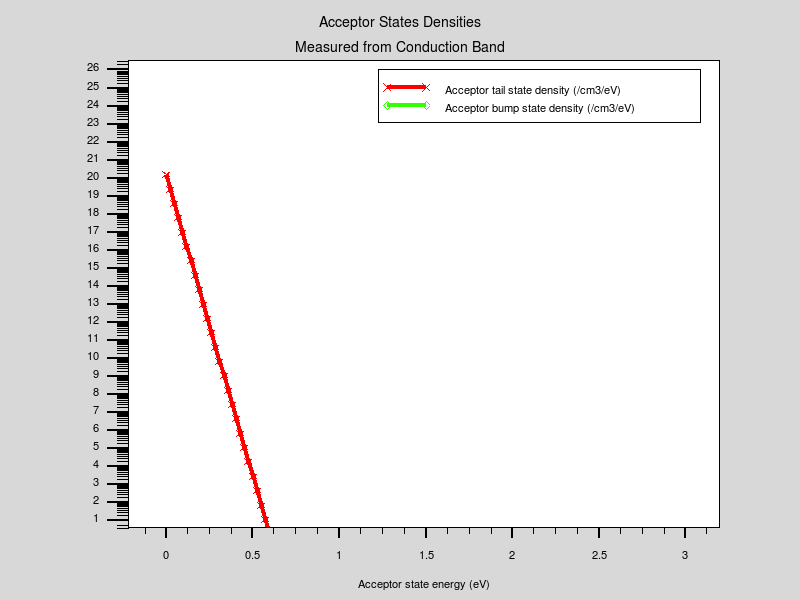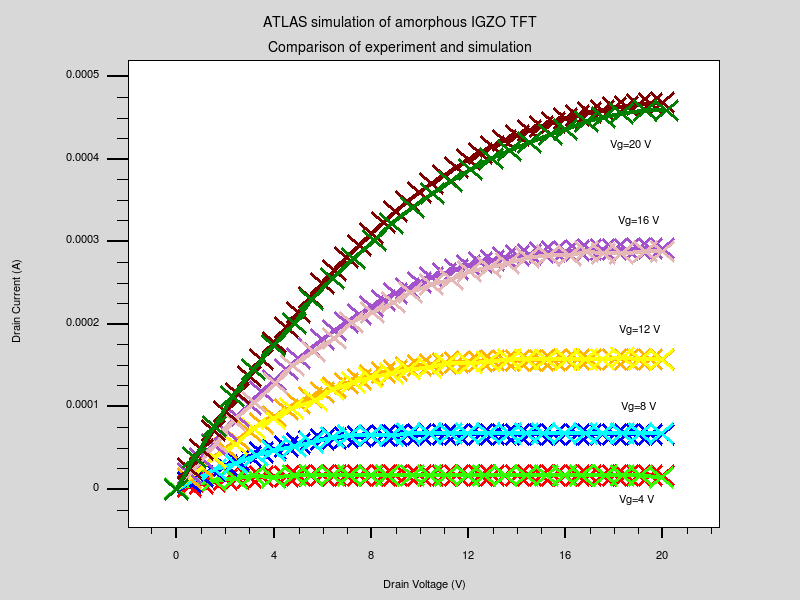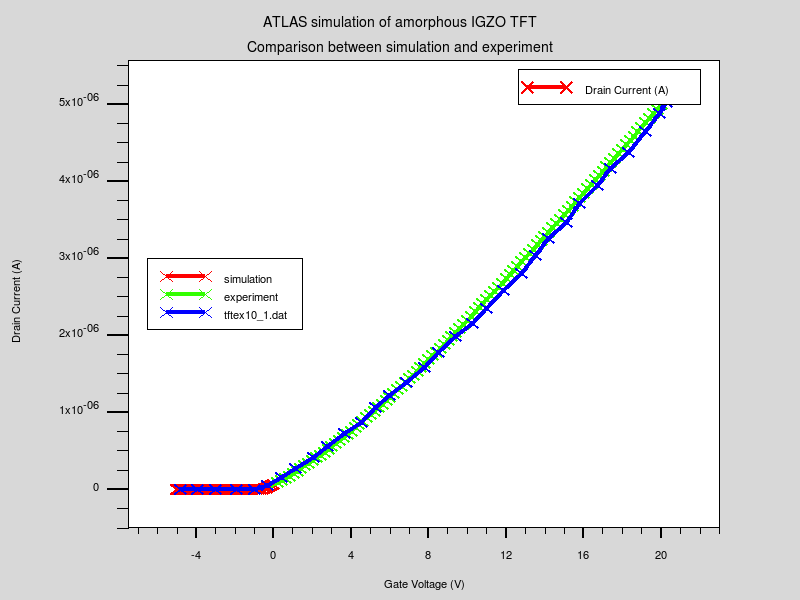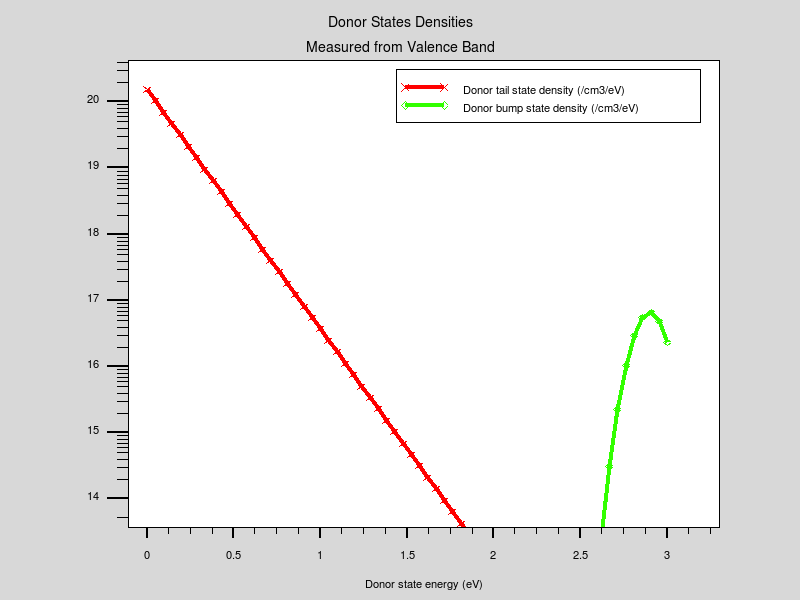基于SILVACO ATLAS的a-IGZO薄膜晶体管二维器件仿真(01)
最近因为肺炎的缘故,宅在家里不能出门,就翻了下一些资料,刚好研究方向是这个,就简单研究了下。参考资料主要如下:
1.《半导体工艺和器件仿真软件Silvaco TCAD实用教程》 唐龙谷 2014
2.《长安大学 半导体工艺与器件仿真指导书》 张林 2015
引用本科时社团一姐的一句话:学习PS的精髓在于毁图。个人浅见,学习仿真的话还是要根据实例拆解分析比较快。重复,我是新手,只是个人浅见。
官网实例:https://www.silvaco.com/examples/tcad/section41/index.html
tftex10.in : Amorphous IGZO TFT Simulation:
# (c) Silvaco Inc., 2019
# This example demonstrates simulation of amorphous IGZO (indium galium
# zinc oxide) TFT. Here we reproduce the results from:
#
# Fung, T., Chuang, C., Chen, C., Katsumi, A., Cottle, R., Townsend, M.,
# Kumomi, H., and Kanicki, J., "Two-dimensional numerical simulation of
# radio frequency sputter amorphous In-Ga-Zn-O thin-film transistors",
# J. Appl. Phys., V. 106, pp. 084511-1 through 084511-10.
#
# Comparisons with experiment are included.
#
# This first part of the input deck simulates Id-Vg.
#
go atlas mesh width=180 outf=tftex10_1.str master.out x.m l=0 s=0.25
x.m l=40 s=0.25
y.m l=0 s=0.0005
y.m l=0.02 s=0.0005
y.m l=0.12 s=0.005
#(划分网格)
# The device is composed of a 20 nm layer of IGZO deposited
# 100 nm oxide on a n++ substrate that acts as the gate.
#
region num=1 material=igzo y.min=0 y.max=0.02
region num=2 material=sio2 y.min=0.02 y.max=0.12
#(定义材料)
elec num=1 name=gate bottom
elec num=2 name=source y.max=0.0 x.min=0.0 x.max=5.0
elec num=3 name=drain y.max=0.0 x.min=35.0 x.max=40.0
#(定义电极)
# We define the gate as N.POLY. This pins the gate workfunction
# to the conduction band edge of silicon.
#
contact num=1 n.poly
#
# We also define a workfunction for the source and drain that
# is very close to the conduction edge. In the reference the
# authors observed that without a workfunction the results for
# ohmic boundaries were not significantly different than the
# Schottky model.
#
contact num=2 workf=4.33
contact num=3 workf=4.33
#(定义接触条件)
models fermi
#
# Key to the characterization of amorphous materials is the
# definition of the states within the band gap.
#
defects nta=1.55e20 ntd=1.55e20 wta=0.013 wtd=0.12 \
nga=0.0 ngd=6.5e16 egd=2.9 wgd=0.1 \
sigtae=1e-15 sigtah=1e-15 sigtde=1e-15 sigtdh=1e-15 \
siggae=1e-15 siggah=1e-15 siggde=1e-15 siggdh=1e-15 \
dfile=tftex10_don.dat afile=tftex10_acc.dat numa=128 numd=64
#(定义缺陷分布)
# From here we simply extract the Id-Vg characteristic
#
solve init
solve prev
#???
solve vdrain=0.1
save outf=tftex10_0.str
log outf=tftex10_1a.log
solve vgate=0 vstep=-0.1 vfinal=-5 name=gate log off
#???
load inf=tftex10_0.str master
solve prev
log outf=tftex10_1b.log
solve vstep=0.2 vfinal=20.0 name=gate
#
# And we compare the simulation with experimental data reported in
# the reference.
#
tonyplot -overlay tftex10_1a.log tftex10_1b.log tftex10_1.dat -set tftex10_1.set
#tonyplot 的 overlay与set命令 ???
tonyplot -overlay tftex10_don.dat -set tftex10_don.set
#绘制施主态密度分布曲线
tonyplot -overlay tftex10_acc.dat -set tftex10_acc.set
#绘制受主态密度分布曲线 go atlas
#
# In the next part of the input deck we extract the Id-Vd family of
# curves. The structure definition is exactly the same.
#
mesh width=180 x.m l=0 s=0.25
x.m l=40 s=0.25
y.m l=0 s=0.0005
y.m l=0.02 s=0.0005
y.m l=0.12 s=0.005 region num=1 material=igzo y.min=0 y.max=0.02
region num=2 material=sio2 y.min=0.02 y.max=0.12 elec num=1 name=gate bottom
elec num=2 name=source y.max=0.0 x.min=0.0 x.max=5.0
elec num=3 name=drain y.max=0.0 x.min=35.0 x.max=40.0 contact num=1 n.poly
contact num=2 workf=4.33
contact num=3 workf=4.33 models fermi defects nta=1.55e20 ntd=1.55e20 wta=0.013 wtd=0.12 \
nga=0.0 ngd=6.5e16 egd=2.9 wgd=0.1 \
sigtae=1e-15 sigtah=1e-15 sigtde=1e-15 sigtdh=1e-15 \
siggae=1e-15 siggah=1e-15 siggde=1e-15 siggdh=1e-15 \
dfile=don afile=acc numa=128 numd=64
#
# Here we calculate the start structures for each of the IdVd
# family by performing an initial gate ramp.
#
#(下面就有点懵了...)
solve solve vstep=0.2 vfinal=4.0 name=gate save outf=tftex10_2.str
solve vstep=0.2 vfinal=8.0 name=gate save outf=tftex10_3.str
solve vstep=0.2 vfinal=12.0 name=gate save outf=tftex10_4.str
solve vstep=0.2 vfinal=16.0 name=gate save outf=tftex10_5.str
solve vstep=0.2 vfinal=20.0 name=gate save outf=tftex10_6.str load inf=tftex10_2.str master log outf=tftex10_2.log
solve vdrain=0.0 vstep=0.5 vfinal=20.0 name=drain load inf=tftex10_3.str master log outf=tftex10_3.log
solve vdrain=0.0 vstep=0.5 vfinal=20.0 name=drain load inf=tftex10_4.str master log outf=tftex10_4.log
solve vdrain=0.0 vstep=0.5 vfinal=20.0 name=drain load inf=tftex10_5.str master log outf=tftex10_5.log
solve vdrain=0.0 vstep=0.5 vfinal=20.0 name=drain load inf=tftex10_6.str master log outf=tftex10_6.log
solve vdrain=0.0 vstep=0.5 vfinal=20.0 name=drain tonyplot -overlay tftex10_2.log tftex10_2.dat tftex10_3.log tftex10_3.dat tftex10_4.log tftex10_4.dat tftex10_5.log tftex10_5.dat tftex10_6.log tftex10_6.dat -set tftex10_2.set quit
官网给出的四张输出图像如下:


自己装的ATLAS还有点问题,这几天先折腾下在跑跑看。
不过毕竟是引用了别人的文献中的数据,与实验室的材料特性还有较大差距,估计要手调了。
总体来说,ATLAS的步骤主要为:
建立网格-定义材料-定义电极以及接触-定义缺陷分布或掺杂-引入模型以及求解方法-求解-Tonyplot输出
要解决的难点主要在于:
1.材料特性微调;
2.缺陷分布调整;
3.理解输出语句,并合理运用;
武汉加油!
基于SILVACO ATLAS的a-IGZO薄膜晶体管二维器件仿真(01)的更多相关文章
- 基于SILVACO ATLAS的a-IGZO薄膜晶体管二维器件仿真(03)
今天逛ResearchGate的时候发现了一个不错的Atlas入门教程:Step by step with ATLAS Silvaco点击链接免费下载.. Atlas代码结构 当然可能有一点太基础了. ...
- 基于SILVACO ATLAS的a-IGZO薄膜晶体管二维器件仿真(08)
进展比较慢啊... 根据江南大学硕士论文IGZO/IZO双有源层薄膜晶体管特性的模拟研究: 其中, gCBa:类受主导带尾态 gVBd:类施主价带尾态 gGd:类施主氧空位态 NDeep:价带尾深施主 ...
- 基于SILVACO ATLAS的a-IGZO薄膜晶体管二维器件仿真(02)
Silvaco的破解用了好久好久,而且之后拷了上次例子的代码,Tonyplot的输出存在报错,还是四连. 当然这个点一下还是会出图的.但是,源代码稍微改了下结构,又有报错,而且程序直接终止. go a ...
- 基于SILVACO ATLAS的a-IGZO薄膜晶体管二维器件仿真(06)
在知网看到了江南大学的硕士论文: 双有源层a-IGZO薄膜晶体管的特性仿真 IGZO/IZO双有源层薄膜晶体管特性的模拟研究 发现,我昨天的文章中参数的设置存在重大失误,如下材料定义语句中: mate ...
- 基于SILVACO ATLAS的a-IGZO薄膜晶体管二维器件仿真(04)
在eetop上有好多好东西啊: Silvaco_TCAD_中文教程1 不过这个教程里是Linux系统的,而且工艺仿真占了比较大的篇幅. defect region=1 nta=5e17 wta=0.1 ...
- 基于SILVACO ATLAS的a-IGZO薄膜晶体管二维器件仿真(07)
今天主要解决一下defect语句: defect region=1 nta=1.55e20 wta=0.013 wtd=0.12 ngd=6.5e16 wga=2 ntd=1.55e20 ngd=0 ...
- 基于SILVACO ATLAS的a-IGZO薄膜晶体管二维器件仿真(05)
关于特性曲线的输出调整: 初代版本 material material=igzo eg300=3.5 nc300=8.5e21 nv300=8.5e21 taun0=1e-9 taup0=1e-9 a ...
- 基于SignalR的消息推送与二维码描登录实现
1 概要说明 使用微信扫描登录相信大家都不会陌生吧,二维码与手机结合产生了不同应用场景,基于二维码的应用更是比较广泛.为了满足ios.android客户端与web短信平台的结合,特开发了基于Singl ...
- 在云平台上基于Go语言+Google图表API提供二维码生成应用
二维码能够说已经深深的融入了我们的生活其中.到处可见它的身影:但通常我们都是去扫二维码, 曾经我们分享给朋友一个网址直接把Url发过去,如今我们能够把自己的信息生成二维码再分享给他人. 这里就分享一下 ...
随机推荐
- ZOJ 4082 Little Sub and his Geometry Problem题解
题意 f(u,v):x小于等于u且y小于等于v的点才对f有贡献,每个这样的点贡献(u-x)+() 思路 =f(u_2,v_2)" class="mathcode" src ...
- python 3 可迭代对象与迭代器
1,可迭代对象 内部含有__iter__方法的对象是可迭代对象 遵循可迭代协议 dir() 检查对象含有什么方法 dir()会返回一个列表,这个列表中含有该对象的以字符串的形式所有方法名.这样我们就可 ...
- python笔记06
python笔记06 数据类型 上个笔记内容补充 补充 列表 reverse,反转. v1 = [1,2,3111,32,13] print(v1) v1.reverse() print(v1) v1 ...
- 518-零钱兑换 II(完全背包-求方案总数)
518-零钱兑换 II(完全背包-求方案总数) 给定不同面额的硬币和一个总金额.写出函数来计算可以凑成总金额的硬币组合数.假设每一种面额的硬币有无限个. 示例 1: 输入: amount = 5, c ...
- PP: Deep r -th Root of Rank Supervised Joint Binary Embedding for Multivariate Time Series Retrieval
from: Dacheng Tao 悉尼大学 PROBLEM: time series retrieval: given the current multivariate time series se ...
- PP: Modeling extreme events in time series prediction
KDD: Knowledge Discovery and Data Mining (KDD) Insititute: 复旦大学,中科大 Problem: time series prediction; ...
- vue 报错碰到的一些问题及其规范
报错信息:Expected error to be handled(需要处理的错误) 这是因为回调函数里面的参数error没有运用到,所以可以不设置参数,或者在回调函数内console.log(err ...
- vs code使用指南
https://blog.csdn.net/weixin_45601379/article/details/100550421
- 呼叫到达率100%,网易云信信令SDK免费上线!
近期,网易云信推出一款稳定可靠.到达率高.扩展性较强的信令通道产品--信令SDK.它能够提供可靠的消息通道,可用于搭建音视频场景下的呼叫邀请机制.信令SDK目前兼容市面上所有主流的音视频SDK,呼叫到 ...
- eslint全局变量报错 xxx is not defined
找到.eslintrc.js,添加 "globals": { "你的全局变量": true }, 如果globals已经存在在里边加入你要忽略检测的全局变量即可 ...


